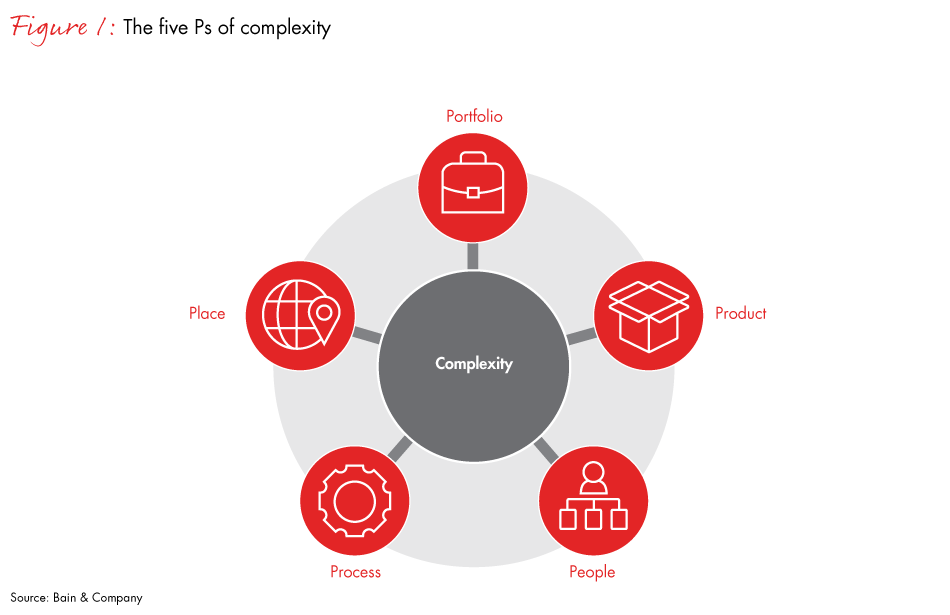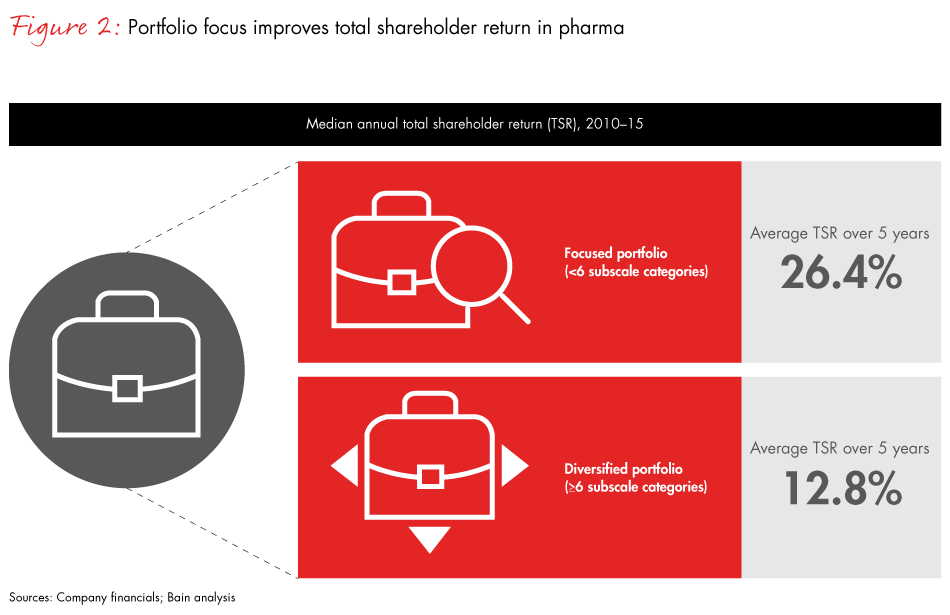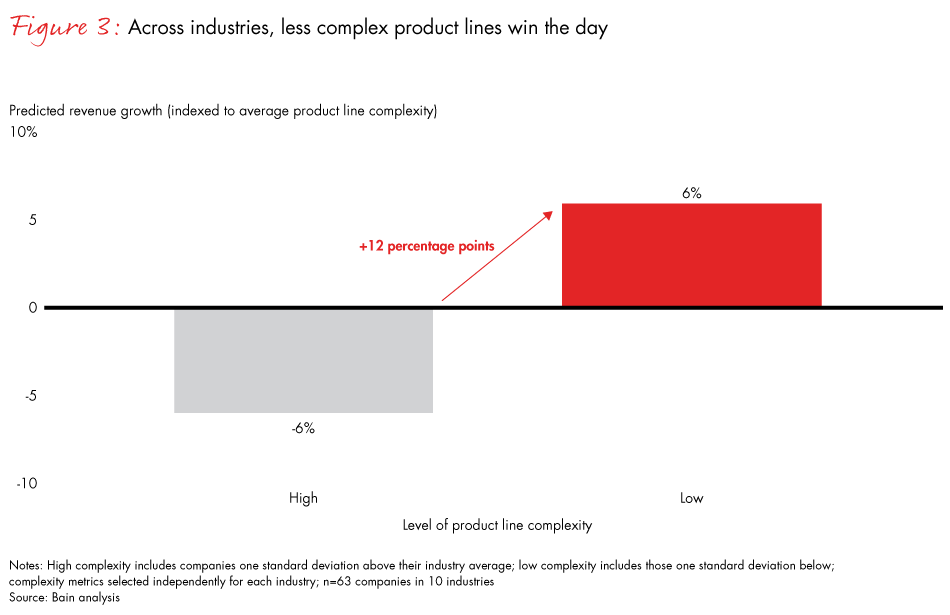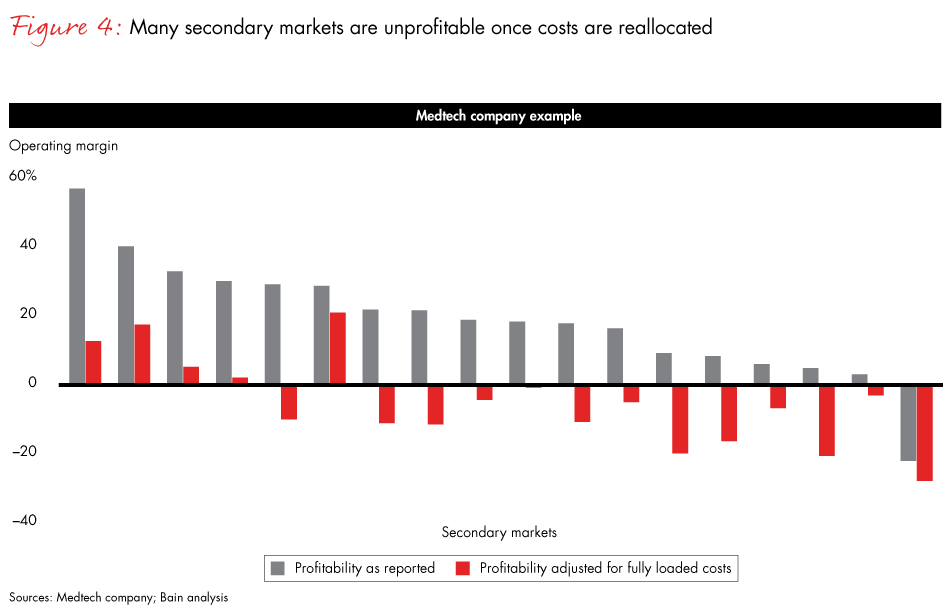Brief

Healthcare manufacturers have long believed that all revenue growth is good. But to increase the top line, many launched new products without addressing legacy versions, entered new categories without a path to leadership and expanded to all corners of the world without sufficient local scale. Mergers and acquisitions increased overall size but weren’t fully integrated and led to a pileup of redundant systems and processes. In an environment of high gross margins and stable or rising prices, the profit generated from these growth strategies outweighed the complexity they created.
Today’s harsher market conditions have proved it is risky to pursue top-line growth at all costs. Companies need to increase revenue and margins just as the hurdle for innovation is increasing and prices often are declining. Under those conditions, complexity creates a serious drag on performance. It slows down decision making, adds hidden costs, impedes innovation and damages customer relationships. Simply put, the very strategies that healthcare companies pursued to deliver growth now undermine it.
As our colleagues have written, complexity is the silent killer of growth. Tackling complexity in a systematic way allows companies to accelerate growth while reducing costs even in the face of continued market pressures. In Bain’s experience, companies that remove unnecessary complexity can achieve above-market growth while also delivering significant margin expansion, typically adding 3–5 percentage points to the bottom line. How? A streamlined organization and portfolio unlock growth potential by focusing a company on the products and services that customers value most, breaking down barriers to collaboration across silos and freeing up funds for innovation. On the cost side, simpler structures and product offerings create efficiencies in manufacturing, research and development (R&D), quality, regulatory and marketing.
Reducing complexity, and the structural costs that it creates, can also help the general manager build a healthier profit and loss statement (P&L)—one that is able to withstand market volatility without depending on discretionary cost-cutting and slash-and-burn headcount reductions.
This is not to say, of course, that all complexity destroys value. Companies with diverse businesses and capabilities can offer customers a more comprehensive value proposition, which may include more extensive product offerings, value-added services and logistics support. However, leadership teams must determine whether customers truly value the breadth of offerings or if, in fact, they find them confusing or marginally relevant. In that case complexity is likely to be undercutting performance and should be eliminated.
What is complexity, and why does it matter?
Leading companies understand that there are different kinds of complexity, and they seek to reduce each type. We see five important types of complexity: portfolio, product, place, process and people. The five Ps of complexity are interrelated, and addressing one will often help confront others (see Figure 1).

Portfolio complexity is a measure of how related a company’s businesses are to one another. Companies with high portfolio complexity have fragmented businesses across different segments or therapeutic areas. A key symptom: Operating units have little in common across areas such as customers, competitors and capabilities.
Why it matters: Fragmented businesses often lack critical scale and consume disproportionate resources from shared functions and capital that could be deployed more productively elsewhere. Bain research shows that category leadership in both pharma and medtech delivers higher total shareholder returns (see Figure 2).

In the pursuit of the benefits of growth, many manufacturers in pharma and medtech assembled large portfolios of businesses. In some cases they built leadership positions in categories that helped deliver superior economics through customer loyalty, improved commercial advantage, value-added services and accelerated innovation. But in many situations, portfolios were saddled with less competitive businesses in unrelated categories, few of which received the appropriate level of investment or management attention.
Companies with more complex business portfolios typically are burdened with higher general and administrative (G&A) costs as a percentage of sales because key functions, such as regulatory oversight, quality control, marketing, human resources, information technology and finance, must serve disparate needs. With a fragmented set of businesses, it’s also more difficult to create supply chain efficiencies in manufacturing or supplier relationships. When companies scatter capital and management attention across a multitude of businesses, they starve their core business of resources. The result of subscale positions is often higher costs and lower growth, as we discussed in In Vivo ("Category Focus Rewards Biopharma Shareholders").
Product complexity is the proliferation of products and stock-keeping units (SKUs) that are no longer part of the growth trajectory of the business; and overlapping formulations, products and generations that do not benefit customers.
Why it matters: Rampant product complexity drives up cost, and to the surprise of many, does not contribute significantly to total revenue or growth (see Figure 3).

For years healthcare companies developed new product lines, new formulations and new generations of existing products in the race to innovate, respond to customer demands and polish their brand image. New versions were designed to improve functionality and outcomes, but they rarely triggered the retirement of prior-generation products, as they commonly do in other industries (try buying an iPhone 5 at your local retailer). Rather, pharma and medtech companies sold older products alongside new ones, believing older versions still addressed some customers’ needs. That approach led to a lack of discipline in managing the legacy product portfolio and often limited the ability to build share for the new product lines. In many cases, companies used legacy products or formulations to serve lower-cost tiers or to enter emerging markets, based on the assumption that they are cheaper to manufacture and sell, which is rarely true when total production volumes decline. In addition, as the industry pursued mergers and acquisitions, few companies integrated their portfolios, instead keeping competing products from both companies in the marketplace.
Product complexity confuses customers and sales representatives with a fragmented portfolio of similar and undifferentiated products. It also siphons resources away from the company’s most important products since a legacy portfolio requires continued attention and investment. The highly complex portfolio at one healthcare company consumed nearly half of the R&D budget to support the legacy portfolio at the expense of innovation, while at other healthcare companies, fragmented product portfolios divert funding from marketing and commercial budgets that is vital to promoting new products.
Product complexity also drives up costs in G&A and manufacturing. Functions including quality assurance and control, regulatory, customer service, legal compliance and sales and operations planning must support complex and fragmented portfolios, even if those products generate little return. Product proliferation also raises manufacturing costs and inventory levels. Plants must maintain dedicated lines or invest in expensive changeovers and equipment for low-volume SKUs and maintain safety stock across many more product lines. Older products suffer more often from quality problems, adding to higher customer service support costs. Finally, product proliferation results in a multitude of suppliers, making it harder for management to focus on a core group of strategic partners that can offer better cost and service.
Place complexity is geographic fragmentation. Key symptoms: highly dispersed revenue streams and multiple markets with subscale revenues.
Why it matters: For healthcare companies, many markets do not have a favorable path to profitability, and selling costs are prohibitive. But losses go unnoticed because financial systems rarely capture the full burden of geographic complexity.
In the race for revenue at any cost, healthcare companies also pursued sales across a broad range of geographies. Many leadership teams assume the revenue from new markets is accretive, but the full cost of operations including regulatory, customer service, quality, manufacturing, labeling, shipping, R&D, monitoring and compliance often make these markets unprofitable (see Figure 4). Financial systems rarely capture the cost of the geographic complexity—they typically are built to capture marginal costs rather than total costs. Management and marketing teams end up investing too much time and energy in markets with marginal returns, instead of growing share in markets that have the greatest potential for scale and leadership economics.

Process complexity refers to duplicative and inefficient business processes throughout the organization. Key symptoms: functional, system and IT redundancy and manual workarounds.
Why it matters: Complex processes slow decision making and execution and blur accountability.
When healthcare companies grow rapidly across product lines and geographies, basic business processes become more complex. Management teams increase oversight, regional and local stakeholders multiply, and process localization grows. Many processes are tied to legacy IT systems, so complexity soars when companies merge without doing the necessary system integration. Healthcare companies often have overlooked these process challenges, assuming complexity is a given. Successful companies tackle process complexity to reduce run rates, increase the speed of decision making, lower costs and make the business more productive.
Process complexity often leads to multiple decision nodes throughout the system, diluting decision ownership. As a result, key processes such as new product design, supplier and manufacturing transfers and product redesign become slow and labor intensive. Slower decisions and processes impede customer responsiveness, undermine growth and increase costs.
People complexity is the proliferation of employees and managers with unclear roles and accountability. A key symptom: many organizational layers between customers and senior management.
Why it matters: Whenever portfolios, products, places and processes become complex, people complexity grows, too. Unclear decision rights, misaligned incentives and duplicative functions slow decision making and execution, inhibit innovation and add costs to the system.
The clearest signs of people complexity are too many spans and layers of management, and organizational structures with far too many nodes. When the customer interface is too far removed from the C-suite, the result is reduced market sensitivity and agility. Senior managers have more limited spans of control, increasing costs without creating incremental value. Organizations with too many spans and layers risk leaving R&D cut off from the front line, investing primarily in safe projects rather than innovations that might command more value.
When an organization becomes so complex that no one person is able to navigate all its functions and silos, general managers become less accountable. Over time, their skills diminish as the company develops into a collection of cost centers where each defends its own budget. In that setting, few general managers focus on the mission of growing revenues and margins.
People complexity also undermines the efficiency of corporate or shared services. Organizations that lack clear roles for shared functions to support multiple internal stakeholders are unable to leverage administrative costs.
Why tackling complexity is hard
If complexity is such a drain on growth and margins, why do companies struggle in their efforts to tame it? There are three key reasons, in our experience:
First, the costs of complexity often are hidden—they don’t appear in financial systems or P&Ls. Standard cost accounting spreads costs across product lines and geographies instead of clustering costs by activity. So even when leadership teams believe that complexity adds costs, it’s hard to prove with readily available data.
Second, companies often do not approach complexity reduction from the perspective of what’s best for their customers. Complexity reduction, when done correctly, improves the customer experience and makes a company’s value propositions more powerful. Unfortunately, many companies think they have to make a trade-off between complexity and growth, when in fact reducing complexity will help accelerate growth. Companies that frame complexity reduction as primarily a cost-cutting initiative, separate from what’s best for their customers and employees, inevitably fail to achieve their full potential.
Finally, many companies fail to capture the full cost savings from complexity reduction. Streamlining a product or service portfolio does not automatically eliminate costs or improve business performance. Line owners must adopt new cost targets. Managers need to reset budgets. Dedicated teams have to redesign processes and procedures to capitalize on the newly simplified portfolio. Over time, companies can take many other actions to enhance cost savings, such as reallocating R&D funds to reflect the new product strategy, consolidating vendors, reducing spare-part inventories and simplifying manufacturing schedules.
These three factors make addressing complexity different from other strategic initiatives—and point to the need for a new approach.
A path forward
While tackling complexity is hard, it is critically important to performance. Successful companies follow five basic principles to deliver stronger revenue and profit growth in today’s challenging healthcare landscape:
Establish a cross-functional team and governance structure: Complexity flows across functions, so rooting it out requires a cross-functional team of commercial divisions, R&D and operations. In our experience, complexity reduction efforts are most successful when commercial and marketing executives lead them. They help focus decisions around a winning portfolio and ensure new disciplines become embedded in management processes.
Build a cost-of-complexity model that captures all embedded costs: The costs of an individual business unit, geography, product or process can be difficult to identify, so it is critical to develop objective data that highlights the total cost of complexity. Often this requires a more nuanced, activity-based methodology to allocate costs, and an understanding of what sets in motion new activities and resource allocation.
Develop a clear business case for removing complexity based on what customers value: Armed with data on the total cost of complexity and proprietary customer insights, leadership teams can decide which products and services add value to the business and which do not. In some instances companies may decide the high cost of portfolio complexity is justified because customers value those products.
The key is understanding exactly what customers in each segment want from the product in question, and designing it to those specifications. Leadership teams may also decide adding complexity is warranted when establishing a beachhead in a new market, for instance. The most effective approach is to build a business case based on an enterprise-wide view of the return on investment, since the benefits and costs of eliminating complexity often do not sit within the same P&L or operating unit.
Strengthen organizational alignment: In our experience, companies that reduce complexity to unleash growth—instead of indiscriminately cutting costs—empower employees to find incremental opportunities to simplify their activities and focus on high-priority brands and priority markets.
Coordinate steps to reduce complexity and keep it out: Complexity programs are a multiyear effort that require a well-coordinated, cross-functional team with appropriate governance. Participants should remain in sync on both the activity milestones and actions to remove costs. Managers can use trigger events such as a merger or the launch of a new product line to signal the opportunity to decrease complexity by eliminating roles, projects and other resource-draining activities.
Leading companies redesign internal processes to ensure complexity does not creep back in. They build in clear guidelines to define the criteria for adding new geographies, for example, and establish rules for eliminating prior generations of products a few years after a new launch.
Fit for a fast-changing market
The top performers in today’s healthcare market are transforming their growth strategies. They excel at category leadership, cost reduction and customer-focused innovation. Complexity stands in the way of achieving these goals.
Tackling the five Ps of complexity enables companies to focus their attention on their most important priorities and create streamlined organizations that are fit for a fast-changing market. Companies that reduce unnecessary complexity build competitive advantage and position themselves to outperform for years to come.
Todd Johnson is a partner in Bain & Company’s New York office. Patrick O’Hagan is a partner in Bain’s Boston office. Chuck Whitten is a partner in Bain’s Dallas office. Tim van Biesen is a partner in the company’s New York office.



